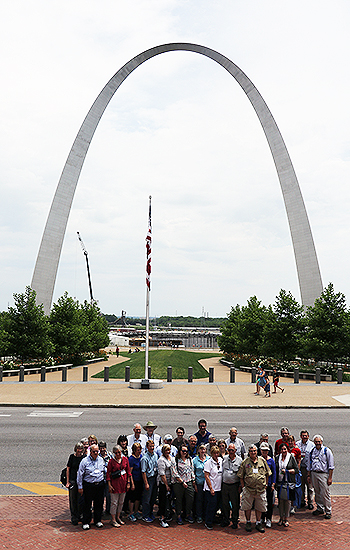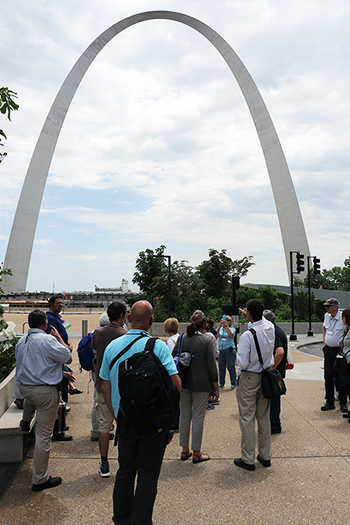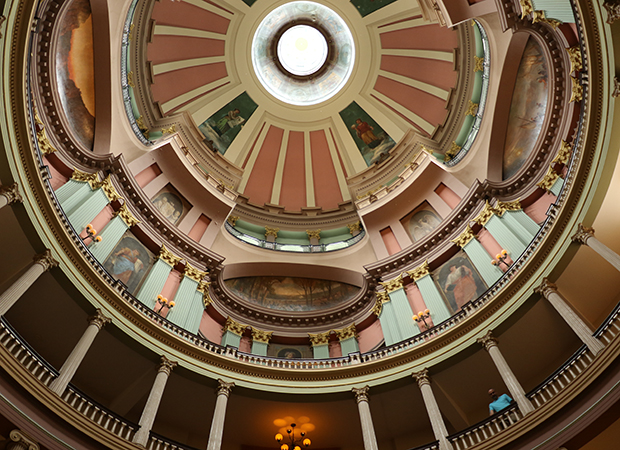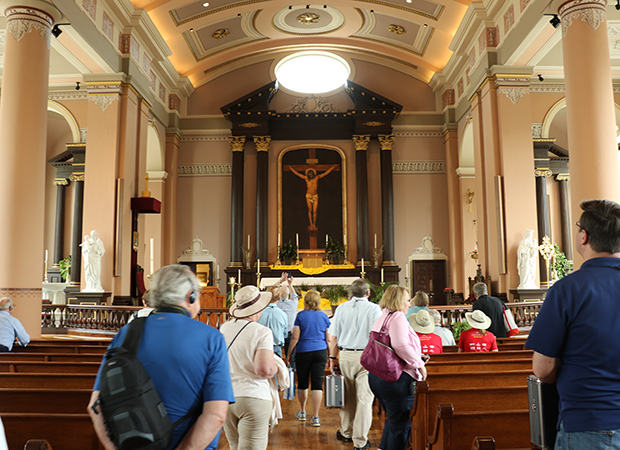Mormon History Association Conference Convenes in St. Louis
Contributed By R. Scott Lloyd, Church News staff writer

St. Louis, Missouri, cityscape as viewed from inside the top of Gateway Arch in St. Louis, Missouri, June 1, 2017.
Related Links
St. Louis, Missouri, the “gateway to westward expansion,” is the locale for this year’s Mormon History Association Conference, which got underway Thursday, June 1, with two pre-conference tours that each included a visit to the city’s famous Gateway Arch.
Some 350 Mormon history enthusiasts have convened at the St. Charles Convention Center adjacent to St. Louis for the two-day conference over Friday and Saturday. More than 100 presenters and panelists have conducted more than three dozen sessions pertaining to Mormon history. Much of the content focused on St. Louis and the theme “Crossing and Dwelling in Mormon History,” alluding to the city’s role as the starting point for the settlement of the West.
The bus tours were each highlighted with a visit to the city’s iconic Gateway Arch, a historic site more formally known as the Jefferson National Expansion Memorial.
Conference attendees rode trams to the top of the arch’s interior. There, they gazed out of windows affording views of the Mississippi River on the east and the cityscape on the west, including the Old Courthouse, where the famous Dred Scott decision of the 1800s was first argued. The eventual U.S. Supreme Court decision infamously held that a slave, even one that had been freed, could not be a U.S. citizen and therefore could not sue in federal courts. This decision contributed to the heightened tensions that eventually brought on the Civil War.
Part of the tour dealt with the Mormon connection to the area in which the arch and surrounding park have been constructed. For example, the concert hall site is located on the south side of Market Street between second and third streets.

With the Gateway Arch in the background, members of the Mormon History Association pose on the steps of the Old Courthouse during a pre-conference tour in St. Louis, Missouri, on June 1, 2017. Photo by R. Scott Lloyd.

The Gateway Arch in St. Louis, Missouri, on June 1, 2017, during a pre-conference tour. Photo by R. Scott Lloyd.

From a distance, members of the Mormon History Association view the Gateway Arch in St. Louis, Missouri, on June 1, 2017, during a pre-conference tour. Photo by R. Scott Lloyd.
“Mormon Sabbath day meetings were held twice each Sunday in the concert hall between 1848 and 1854,” said St. Louis resident and Mormon History Association member Tom Farmer as he conducted one of the tours. He continued, “The Church rented the concert hall part-time from 1848 to 1854 for the 3,000–4,000 Saints who lived in the area.”
When the owner of the concert hall was going to raise the rent, the Church members moved to a Methodist chapel in 1854, which they rented on a full-time basis. The concert hall no longer stands, but it was located to the rear of the landmark “Old Cathedral,” or Basilica of Saint Louis, King of France, the first Catholic cathedral west of the Mississippi River.
Tour attendees visited the cathedral, which was dedicated in 1834 and, with the Old Courthouse, is one of only two remaining structures in the city that predate the St. Louis fire of 1849.

The Old Courthouse in St. Louis, Missouri, where the historic Dred Scott decision was first argued, June 1, 2017. Photo by R. Scott Lloyd.

View of the dome inside the rotunda of the Old Courthouse in St. Louis, Missouri, where the historic Dred Scott decision was first argued, June 1, 2017. Photo by R. Scott Lloyd.

Interior of the Old Cathedral in St. Louis, Missouri, one of two remaining structures, including the Old Courthouse, that predate the St. Louis fire of 1849. Photo by R. Scott Lloyd.

Tom Farmer, local historian and member of the Mormon History Association, tells other MHA members about the grave containing two children of James and Emily Hart. James Hart was the second stake president in St. Louis. Their children both died in 1856, and they left shortly afterward to join the Church members who had gone to Utah. Photo by R. Scott Lloyd.

A new gravestone installed by the Mormon Battalion Association for Dr. George B. Sanderson, a physician who treated members of the battalion. He was called “Dr. Death” by some, but the association now believes that was unjust. Photo by R. Scott Lloyd.

Westward settlement exhibit inside the Old Courthouse, a landmark near the Gateway Arch in St. Louis, Missouri, June 1, 2017. Photo by R. Scott Lloyd.
